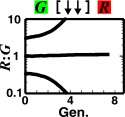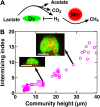Strong inter-population cooperation leads to partner intermixing in microbial communities
- PMID: 23359860
- PMCID: PMC3552619
- DOI: 10.7554/eLife.00230
Strong inter-population cooperation leads to partner intermixing in microbial communities
Erratum in
-
Correction: Strong inter-population cooperation leads to partner intermixing in microbial communities.Elife. 2014 Apr 16;3:e02945. doi: 10.7554/eLife.02945. Elife. 2014. PMID: 24740970 Free PMC article. No abstract available.
Abstract
Patterns of spatial positioning of individuals within microbial communities are often critical to community function. However, understanding patterning in natural communities is hampered by the multitude of cell-cell and cell-environment interactions as well as environmental variability. Here, through simulations and experiments on communities in defined environments, we examined how ecological interactions between two distinct partners impacted community patterning. We found that in strong cooperation with spatially localized large fitness benefits to both partners, a unique pattern is generated: partners spatially intermixed by appearing successively on top of each other, insensitive to initial conditions and interaction dynamics. Intermixing was experimentally observed in two obligatory cooperative systems: an engineered yeast community cooperating through metabolite-exchanges and a methane-producing community cooperating through redox-coupling. Even in simulated communities consisting of several species, most of the strongly-cooperating pairs appeared intermixed. Thus, when ecological interactions are the major patterning force, strong cooperation leads to partner intermixing.DOI:http://dx.doi.org/10.7554/eLife.00230.001.
Keywords: S. cerevisiae; cooperation; ecological interactions; methanogenic biofilms; microbial communities; pattern formation; syntrophic biofilms.
Conflict of interest statement
The authors have declared that no competing interests exist.
Figures














References
-
- Breugelmans P, Barken KB, Tolker-Nielsen T, Hofkens J, Dejonghe W, Springael D. Architecture and spatial organization in a triple-species bacterial biofilm synergistically degrading the phenylurea herbicide linuron. FEMS Microbiol Ecol. 2008;64:271–82. doi: 10.1111/j.1574-6941.2008.00470.x. - DOI - PubMed
Publication types
MeSH terms
Grants and funding
LinkOut - more resources
Full Text Sources
Other Literature Sources
Molecular Biology Databases

